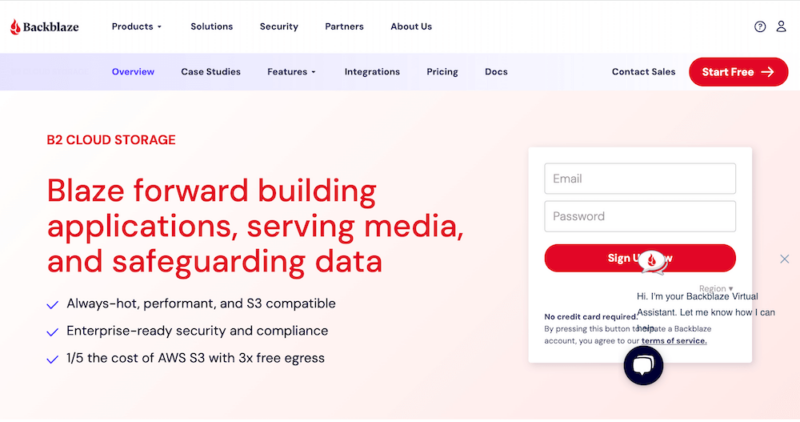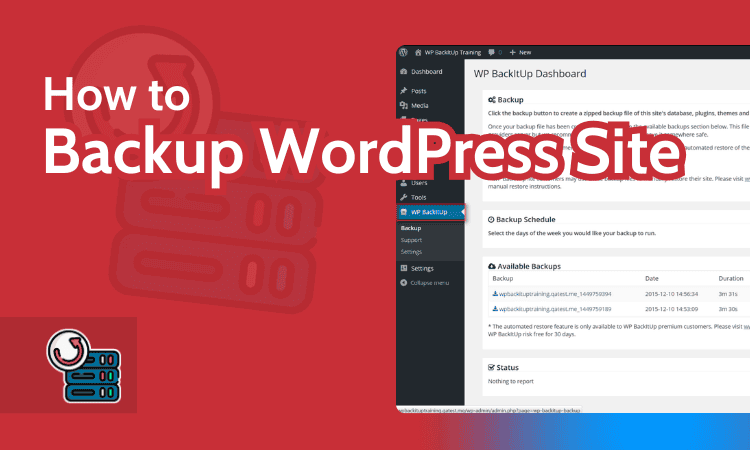How to Back Up a WordPress Site in 2024
If you’re wondering how to back up a WordPress site, there are multiple factors to consider. For instance, the backup type, website size, backup frequency, level of encryption and ease of use will all play into your choice. Ultimately, backing up your site insures your data from potential loss.
Learning how to back up a WordPress site is essential to prevent permanent data loss due to bugs, software errors and cyberattacks. Backing up WordPress is like having an insurance policy for your website. In case of a breakdown, you can roll back up like nothing happened.
If you run an e-commerce, business or personal website on WordPress, you should create backups. To help you, we highlight three different ways to back up WordPress files: managed WordPress hosting, plugins and manual backups. We also discuss how to choose cloud storage for WordPress and recommend some providers. But first, let’s see why a WordPress backup is important:
-
04/23/2024
Rewritten to include current information on features, pricing and procedures.
Why You Need a WordPress Backup
You need a WordPress backup to avoid losing your website data and files in case of human error, bugs, malicious activity or web host malfunctions. You can easily restore your website and keep your business safe from unnecessary downtime and revenue losses. A WordPress backup offers the following benefits:
- Safeguards site data: Backing up your website prevents file and data losses that may result from host malfunctions, cybercrime or human error.
- Saves time: It saves you from spending time recreating the website from scratch after an incident.
- Saves money: It saves you the cost of remaking the site, along with repurchasing plugins and other paid add-ons.
- Enables quick restoration: You can recover your site with just a few clicks, relieving the stress of obtaining expert assistance.
- Allows prompt migration: You can export your site to another domain or web host with ease using an effective backup service.
Top 3 Ways to Back Up Your WordPress Site
The three main ways of backing up a WordPress site include using plugins, using host-provided tools or performing a manual backup. Let’s take a closer look at each method.
| Method: | Pros: | Cons: |
|---|---|---|
| WordPress Plugin | 1. Automatic backups 2. Real-time backups 3. Backs up in the cloud | 1. Can be expensive 2. Requires dashboard access |
| Host-Provided Backup Tool | 1. Daily automatic backup 2. On-demand backup 3. Built-in backup feature | 1. Only available with expensive hosting 2. May not store data separately |
| Manual Backup | 1. No dashboard access required 2. Download raw data & files | 1. Time-consuming 2. No automated options 3. Prone to human error |
1. Using a WordPress Plugin
Plugins are among the most popular solutions for backing up WordPress sites. With plugins, you can schedule automatic backups to run at specific times. You can also set real-time backups that activate whenever you make changes to your WordPress site.
Using WordPress plugins to back up data lets you save your files on external cloud services like Google Drive and Dropbox. On the downside, WordPress plugins may require you to pay before you can access top-tier features. Additionally, you must have access to your WordPress dashboard to configure the plugin and set your backup preferences.
Pros:
- Schedules automatic backups
- Allows real-time backups
- Can back up in the cloud
Cons:
- Can be expensive
- Requires dashboard access
How to Choose the Best WordPress Backup Plugin
WordPress doesn’t offer a built-in backup system, making plugins necessary for everyone who wants to safeguard their site files and data. They offer a no-code solution to WordPress users and are easy enough for beginners to use without a struggle. Keep in mind that you need to have a premium WordPress account to download and use plugins.
Picking the best WordPress backup plugin requires a strategic approach, especially with so many options on the market. Use the following criteria to choose a reliable plugin for your WordPress website.
- Ease of use
- Automated backups
- Encryption
- Backup storage location
- Incremental backups
- Complete backup scheduling
- Click restore feature
Top WordPress Backup Plugins
According to these criteria, here are the best WordPress backup plugins:
- UpdraftPlus — Its free version lets you store backups in the most popular remote storage locations. The UpdraftPlus WordPress backup plugin only offers incremental backups on premium plans.
- BlogVault — Incremental and daily automatic backups are done on its encrypted cloud servers. BlogVault is a great choice if you manage multiple WordPress sites.
- Jetpack Backup — Jetpack’s real-time backup features log every change made on a WordPress site, allowing for quick breach-point identification and restoration.
Of all the handy plugins available, UpdraftPlus is the most downloaded and widely used. It has been installed on more than 3 million websites around the world. The service’s free option has enough features to successfully back up your site without requiring payment. The Premium plan is ideal for people who need more advanced backup features.
How to Set Up Automatic Backups for Your WordPress Website
Setting automatic backups will save you time and effort while letting you perform consistent backups. These backups are usually scheduled using plugins and set to run without manual prompts. Note that the backup process may vary depending on the plugin since each plugin uses its own customized layout.
- Navigate to your WordPress dashboard.
- Click the plugin you want to use.
- Click the “backup” option and locate the “automatic backups” or “scheduled backups” tab.
- Select a schedule for how often you’d like the backups to run. This can be daily, every two days, weekly, monthly, quarterly or even yearly.
- Click the “schedule” button to confirm that it has been set. Some plugins will also state when the next backup is expected to run.
- Choose your preferred storage location since most plugins allow you to save your data on third-party cloud services.
2. Host-Provided Backup Tool
Host-provided backup tools usually come built into WordPress-managed hosting services. Many of these tools perform automatic backups daily, with the option for on-demand backup when needed. Since it’s a built-in feature, you won’t have to spend more to get it.
The main disadvantage of the hosting provider backup method is that it often only comes with expensive hosting services. Some of these tools don’t store your data separately. This is counterproductive since you may not be able to restore the backed-up data if the host server fails.
Using separate storage allows you to access and retrieve a copy of your website in case anything happens to the host.
Pros:
- On-demand backup available
- Daily automatic backup
- Built-in feature
Cons:
- Only available with expensive hosting
- May not store data separately
How to Do a WordPress Website Backup Through Your Web Host
Most web hosting services have a built-in backup tool to create site backups on demand. Essentially, the tool backs up the user’s website daily and saves the data in a safe off-site location. This makes it more reliable than cPanel, which stores your site data on the same server that hosts your site by default.
It’s essential to note that each WordPress host uses a unique interface, so the backup steps may vary.
- Log in to the hosting dashboard.
- Choose the WordPress site you’d like to back up.
- Navigate to the “backup” tab and click on it.
- Select the “manual backups” option, also known as “on-demand backups” on other hosting services.
- Click the “start backup” or “back up now” button to begin the process.
Your host will commence immediately to save your files and data in a separate location from your WordPress site. Some web hosts also give you the option to download the saved files onto your computer.
3. Manual WordPress Database Backup
Manually backing up your WordPress site doesn’t require access to the dashboard. You can choose to get your data in raw form with this option. Use FTP or phpMyAdmin on your web hosting service to complete the manual backup process. Using the cPanel dashboard is another manual backup method — that is, if your host provides this option.
Manual backup works for both CMS and DMS, but it’s time-consuming and inconvenient. You can’t set an automated backup schedule, so completing it relies solely on your availability. In addition, manually backing up your WordPress site leaves room for human errors. For these reasons, it’s our least recommended way to back up your WordPress website.
Pros:
- No dashboard access required
- Can download raw data & files
Cons:
- Time-consuming
- No automated options
- Prone to human error
How to Choose Cloud Storage for WordPress Backups
Choose a cloud storage solution that suits your website’s size and backup requirements. Do you need a daily, weekly or monthly backup? You should also choose a service that fits your budget and storage capacity needs. Check the level of encryption offered to see whether it will suffice for your website.
Look into the service’s privacy policy to ensure you’re comfortable with how they’ll handle your data. Customer support should be accessible, reliable and responsive. We recommend cloud services that give you phone, chat and email support.
Backing up your WordPress website to cloud storage helps reduce the chances of suffering server downtime or site breakdown due to WordPress errors. You can access the backup from anywhere as long as you have an internet connection. It is also secure and scalable.
Top Cloud Storage & Backup Software for WordPress
We recommend the following cloud storage and backup software for your WordPress site. They all offer top-notch security, reliable support, ease of use, sizable storage capacities and unique feature sets.
1. Backblaze B2

Backblaze B2 is easy to use and has well-structured pricing plans compared to competitors like Dropbox. This makes it simple to know what you’re paying for and see whether any extra charges may accrue over time. It’s also a more affordable option compared to other providers. You’ll get a universal data migration service and access to free email support.
Backblaze B2 has fewer global data centers than some competitors like Amazon S3 and Google Cloud. It also only offers one license per computer with no file syncing between two or more computers. It’s also fairly barebones overall compared to its bigger competitors, but you can read our Backblaze B2 review to see if it can do what you need it to.
2. Amazon S3

Amazon S3 is among the oldest cloud storage services. It accommodates users with diverse storage needs since it offers different storage capacities for multiple use cases. Amazon S3 stores your backups and files in cloud storage containers called “buckets.” Each bucket can hold infinite files, and you can have up to 100 buckets.
You’ll get SSE-S3 encryption for your files, keeping them safe from cyberattacks. What’s more, Amazon S3 is part of AWS, which lets users access a diverse tool set. This makes Amazon S3 the most popular cloud storage and backup solution, taking up 31% of the market.
On the downside, the service has a learning curve that sometimes requires users to have technical skills. Its pricing plans aren’t structured well and can therefore get confusing. In addition, some of the available resources are limited to users based on location. Learn more in our Amazon S3 review.
3. Google Drive

Included in the Google Workspace, Google Drive lets you sync files across devices and access backed-up files anytime, anywhere. It offers up to 15GB of free storage with the option to scale up whenever you require more space. You also get access to the Google Workspace tool set, including apps like Google Slides, Sheets, Docs and Forms.
As noted in our Google Drive review, it’s easy to organize files and manage backups from a centralized admin interface. It’s beginner-friendly and supports multiple file types like ZIP, CSS and more. Google Drive is affordable and has a clear pricing structure.
As for its disadvantages, you can only upload and download at speeds of 45 Mbps. In addition, you can only copy and upload 750GB to your Drive daily, and you can sync up to 5TB on a personal account. There have been several concerns about whether Google Drive is secure, which tends to make users shy away from the service altogether.
4. Dropbox

Dropbox saves data in remote databases, securing it from potential server errors. Files are also encrypted using AES-256 to keep them safe from cybercriminal attacks. You can use any device with an internet connection to edit, view and manage your files. There’s also a neat feature that stores any deleted files for 30 days in case you change your mind about trashing them.
Dropbox has handy file sharing and team collaboration features that make work easier among teams. Storage is scalable, allowing you to buy more space as your website backup needs grow.
The biggest downside we found in our review of Dropbox is that it offers tight storage limits to free users (up to 2GB), while its paid plans are expensive. Personal accounts don’t offer zero-knowledge encryption, meaning that Dropbox employees have the encryption keys to those accounts.
Final Thoughts
To wrap up, we’ve discussed everything you need to know about how to back up a WordPress site. We’ve looked at why you need a WordPress backup, the types of backup options available, how to choose the best backup option and much more.
We recommend Backblaze, Amazon S3, Google Drive and Dropbox for WordPress cloud backup. They are loaded with features and effective in website recovery if you experience site data losses.
Which is your preferred WordPress backup option? Have you used any of the recommended tools? If not, which tool do you use? Let us know in the comments, and thank you for reading.
FAQ: WordPress Backup
No, WordPress does not have a built-in backup. However, you can use plugins to perform manual backups or schedule automatic ones. You can also manually back up your site using FTP, cPanel or phpMyAdmin.
You can back up your WordPress site without plugins by using host-provided backup tools or manual backup options like FTP, cPanel and phpMyAdmin.
You can back up and migrate your WordPress site by downloading the backup and migration plugin to your current site. You should then back up the site before exporting it to the new domain or host.
Sources:


